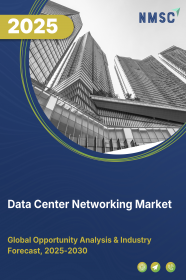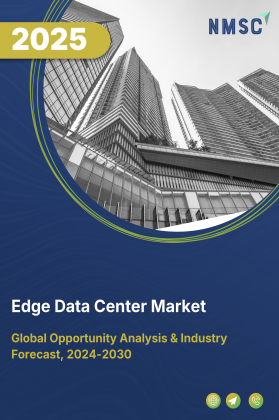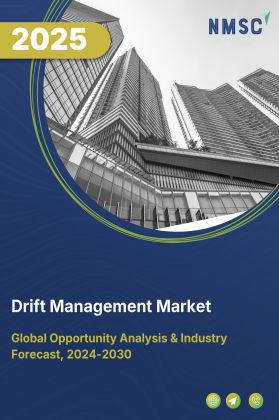
Data Center Networking Market by Component (Hardware (Ethernet Switches, Routers, and Others), Software (Switching Operating Systems, Virtual Switch, Management Software, Controller, and Others), and Services), by Deployment Type (On-Premise Deployment and Cloud Deployment), and by End-Use Industry (Telecom & IT, Government, Colocation, Defense, Retail & E-commerce, Media and Entertainment, Healthcare, Manufacturing, and Others) – Global Opportunity Analysis and Industry Forecast 2025–2030
Industry Overview
The global Data Center Networking Market size was valued at USD 34.64 billion in 2024, and is expected to be valued at USD 39.22 billion by the end of 2025. The industry is projected to grow further, hitting USD 73.20 billion by 2030, with a CAGR of 13.3% between 2025 and 2030.
The data center networking market is experiencing significant evolution, driven by factors such as the exponential surge in data generation, the proliferation of artificial intelligence and machine learning driving the need for high-performance computing, and the expansion of cloud services coupled with the increasing need for robust connectivity infrastructure. However, the market faces restraints including rising energy demands and concerns over grid reliability, which may pose challenges to continuous and efficient data center operations. However, various opportunities for industry players lie in the convergence of edge computing and hybrid cloud environments, offering new ways to optimize data flow, reduce latency, and enhance scalability. This shift has the potential to significantly boost innovation, improve performance, and expand the overall market size.
The Exponential Surge in Data Generation Fuels the Growth of the Market
The expansion of the market is closely tied to the rapid surge in global data generation and consumption. As digital transformation accelerates across industries and reliance on virtual platforms grows, the volume of data being handled daily continues to rise sharply. According to the World Economic Forum, around 463 exabytes of data are expected to be created globally each day by 2025, driven by activities such as social media usage, e-commerce, and streaming. This explosive growth in data demands highly efficient and scalable data center infrastructure, where advanced networking plays a critical role. To manage increasing data traffic and ensure smooth connectivity, organizations are investing in high-performance networking systems, fueling the data center networking market trends.
The Proliferation of Artificial Intelligence and Machine Learning Boosts the Growth of the Market
The rising integration of artificial intelligence (AI) and machine learning (ML) across industries is accelerating the data center networking market demand. These technologies rely on fast, large-scale data processing, which increases the need for high-speed and low-latency network infrastructure within data centers. To support such demanding workloads, operators are increasingly adopting advanced optical technologies with higher data transfer rates like 800G, 1.2T, and 1.6T. This shift is driving significant upgrades in networking hardware, including high-capacity ethernet switches and interconnects such as InfiniBand. As noted in a PwC report, AI is expected to contribute around USD 15.7 trillion to the global economy by 2030, further emphasizing the need for robust, AI-ready data center networks. With more businesses adopting AI-driven solutions, the demand for advanced networking infrastructure continues to rise, strengthening the market outlook for network virtualization.
The Expansion of Cloud Services and the Need for Robust Connectivity Further Boosts the Market
The widespread adoption and expansion of cloud services represent another significant driver for the data center networking industry. Cloud service providers rely heavily on efficient and high-capacity data center networks to deliver their services reliably to a global user base. The transition towards hybrid and multi-cloud environments further complicates network delivery paths, emphasizing the critical need for robust connectivity within and between data centers. As more organizations migrate their workloads to the cloud for scalability, flexibility, and cost-effectiveness, the underlying data center infrastructure, and particularly its networking capabilities, must evolve to handle increased traffic and ensure seamless service delivery. This constant demand for cloud resources directly translates into a need for advanced data center networking solutions, contributing significantly to the overall market growth and industry size.
Rising Energy Demands and Grid Reliability Concerns Hinder the Growth of the Market
The growing demand for power in data centers, particularly driven by the energy-intensive nature of AI workloads, presents a critical restraint on the market's expansion. For instance, Deloitte forecasts a near doubling of global data center electricity usage from 536 terawatt-hours (TWh) in 2025 to approximately 1,065 TWh by 2030. Furthermore, the increasing reliance on natural gas to meet these demands raises environmental concerns regarding decarbonization efforts. Addressing these energy challenges through innovative power management, renewable energy adoption, and advanced cooling solutions is crucial for the sustainable growth of the market.
The Convergence of Edge Computing and Hybrid Cloud Environments Creates Future Growth Opportunities for the Market
The convergence of edge computing and hybrid cloud environments is reshaping the landscape of cloud data centers, opening up significant growth opportunities. As organizations increasingly deploy edge data centers to process data closer to end-users and devices, there is a rising demand for highly responsive, low-latency networking solutions. At the same time, the shift toward hybrid and multi-cloud architectures is driving the need for seamless, secure, and scalable connectivity between on-premises infrastructure and multiple cloud platforms. Together, these trends are fuelling innovation in network design, particularly around cloud interconnects, SD-WAN, and localized data routing, enabling enterprises to meet performance demands while maintaining flexibility and control over their distributed IT environments.
Market Segmentations and Scope of the Study
The data center networking market report is classified on the basis of component, deployment type, end-use industry, and by region. On the basis of component, the market is grouped into hardware, software, and services. Based on hardware, the market is further segmented into ethernet switch, router, storage area network (SAN), network security equipment, application delivery controller (ADC), and others. Based on software, the market is further grouped into switching operating systems (OS), virtual switch, management software, controller. Based on services, the market is further classified into installation and integration, training and consulting, support and maintenance. On the basis of deployment type, the market is segregated into on-premise deployment and cloud deployment. On the basis of end-use industry, the market is divided into telecom & IT, government, defense, retail & e-commerce, media and entertainment, BFSI, healthcare, manufacturing, education, and others. Regional breakdown and analysis of each of the aforesaid segments includes regions comprising of North America, Europe, Asia-Pacific, and RoW.
Geographical Analysis
North America holds the dominant market share in the global data center networking market share, largely due to the rising demand for AI-driven infrastructure. The region faces a growing shortage of available wholesale data center space in key markets, causing rental rates to climb to record levels. This space crunch and high cost are prompting data center expansion in secondary and tertiary cities such as Columbus, Ohio, and Kansas City, Missouri, where affordable real estate, strong connectivity, and reliable infrastructure support large-scale development. These new facilities will require advanced networking solutions to manage increasing workloads and ensure efficient data flow.
In Europe, the data center market is also witnessing considerable growth. The impact of the AI boom is a significant factor influencing the growth potential and infrastructure requirements. In Europe, countries like Germany and Spain are seeing data center developments in multiple cities. This trend is attributed to the availability of cheaper land, power, and fiber infrastructure in these regions, making them attractive for large-scale data center projects. The overall expansion of data center facilities suggests a parallel increase in demand for networking solutions to support these growing capacities.
The Asia-Pacific region presents a dynamic landscape with significant growth potential, particularly in India. India's data center sector is set for substantial expansion, driven by a thriving digital economy, widespread internet access, and the transition to 5G networks. The market size in India is projected to reach an estimated USD 9.27 billion by 2027. Other significant markets within APAC, such as China, Australia & New Zealand, and Japan, are also experiencing considerable demand growth, contributing to the overall robust industry size in the region.
Finally, regions within the Rest of the World, including Latin America, Central and Eastern Europe, the Middle East, and Africa, are at different development stages but show promising growth in network infrastructure demand. As data consumption increases and digital ecosystems expand, these regions are expected to invest in modern data center facilities equipped with advanced networking capabilities. This global momentum highlights the strong and growing need for robust data center networking solutions across both mature and emerging markets.
Leading Companies Advance Networking Infrastructure to Meet the Demands of AI-Powered Data Centers
Leading players in the global data center networking industry are strategically adapting to the transformative wave of Artificial Intelligence (AI), recognizing the immense growth potential this sector holds. For instance, Cisco views Ethernet connectivity for AI data centers as a significant emerging opportunity, aiming to integrate its networking solutions with Nvidia's GPUs. Similarly, Nokia is aggressively targeting this market, investing substantially in its IP unit with the goal of increasing its data center revenue significantly, and has recently launched advanced data center automation platforms tailored for the AI era.
Arista Networks continues to be a key player with its high-performance Ethernet switches and leadership in Software-Defined Networking (SDN), providing the agility modern data centers require. Nvidia, leveraging its Mellanox acquisition, is a dominant force in both InfiniBand and Ethernet connectivity for high-performance computing and AI infrastructure, emphasizing the need for distinct AI networks within data centers. However, these key players face considerable challenges, notably the escalating energy demands of AI workloads and the pressing need for sustainable solutions. Supply chain complexities and rising costs for data center space, especially in primary markets, also pose hurdles. Despite these challenges, the booming AI landscape is driving demand for advanced networking infrastructure.
Key Benefits
-
The report provides quantitative analysis and estimations of the industry from 2025 to 2030, which assists in identifying the prevailing market opportunities.
-
The study comprises a deep-dive analysis of including the current and future trends to depict prevalent investment pockets in the market.
-
Information related to key drivers, restraints, and opportunities and their impact on the industry is provided in the report.
-
Competitive analysis of the players, along with their market share is provided in the report.
-
SWOT analysis and Porters Five Forces model is elaborated in the study.
-
Value chain analysis in the market study provides a clear picture of roles of stakeholders.
Data Center Networking Market Key Segments
By Component
-
Hardware
-
Ethernet Switch
-
Router
-
Storage Area Network (SAN)
-
Network Security Equipment
-
Application Delivery Controller (ADC)
-
Others
-
-
Software
-
Switching Operating Systems (OS)
-
Virtual Switch
-
Management Software
-
Controller
-
-
Services
-
Installation and Integration
-
Training and Consulting
-
Support and Maintenance
-
By Deployment Type
-
On-Premise Deployment
-
Cloud Deployment
By End-Use Industry
-
Telecom & IT
-
Government
-
Defense
-
Retail & E-commerce
-
Media and Entertainment
-
BFSI
-
Healthcare
-
Manufacturing
-
Education
-
Others
By Region
-
North America
-
The U.S.
-
Canada
-
Mexico
-
-
Europe
-
The U.K.
-
Germany
-
France
-
Italy
-
Spain
-
Denmark
-
Netherlands
-
Finland
-
Sweden
-
Norway
-
Russia
-
Rest of Europe
-
-
Asia-Pacific
-
China
-
Japan
-
India
-
South Korea
-
Australia
-
Indonesia
-
Singapore
-
Taiwan
-
Thailand
-
Rest of Asia-Pacific
-
-
RoW
-
Latin America
-
Middle East
-
Africa
-
Key Players
-
Arista Networks, Inc
-
Equinix, Inc
-
Cisco Systems, Inc
-
Digital Realty Trust, Inc
-
Juniper Networks, Inc
-
Broadcom, U.S. Inc
-
NVIDIA Corporation
-
Hewlett Packard Enterprise Development LP
-
ZTE Corporation
-
Extreme Networks, Inc
-
Arrcus, Inc
-
Nokia Corporation
-
Netris, Inc
-
F5, Inc
-
6WIND
Report Scope and Segmentation
|
Parameters |
Details |
|
Market Size in 2024 |
USD 34.64 billion |
|
Revenue Forecast in 2030 |
USD 73.20 billion |
|
Growth Rate |
CAGR of 13.3% from 2025 to 2030 |
|
Analysis Period |
2024–2030 |
|
Base Year Considered |
2024 |
|
Forecast Period |
2025–2030 |
|
Market Size Estimation |
Billion (USD) |
|
Growth Factors |
|
|
Countries Covered |
28 |
|
Companies Profiled |
15 |
|
Market Share |
Available for 10 companies |
|
Customization Scope |
Free customization (equivalent to up to 80 working hours of analysts) after purchase. Addition or alteration to country, regional, and segment scope. |
|
Pricing and Purchase Options |
Avail customized purchase options to meet your exact research needs. |

















 Speak to Our Analyst
Speak to Our Analyst

























